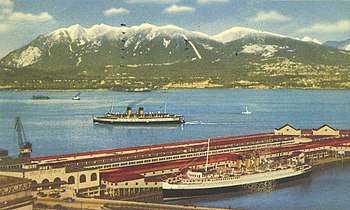CPR Pier B and C
With the expanding trans-Pacific trade, the Canadian Pacific Railway needed to upgrade its wharf space in Burrard Inlet, Vancouver. When the railway was finished in 1886 a small freight shed and small pier was built. At the time the CPR leased ships (Parthia and Abyssinia) and thus the volume of freight was low. The CPR then built its famed RMS Empress of China and began to capitalize on the Pacific run. Tea, silks and other wares were moved across the ocean.

By 1910 the volume of trade had increased such that a second generation of crack ocean liners were built. As such the small, utilitarian facilities had been outgrown. A very large, two decked freight and passenger terminal was built in 1927. This was CPR Pier B and C. Pier A sat immediately to the west and was generally a single decked freight wharf. B and C was the pre-eminent terminal with a Spanish style, First Class lounges, and dock-cranes. Gantries and access ramps were also included to allow cars and foot traffic to cross the expanding rail yards at the foot of Granville Street. Pier B and C sat adjacent to the new CPR Station at Granville Street. It was the premiere wharf on the Pacific shore of Canada—customs and immigration buildings sat nearby to control marine traffic and trade. (other info shows these piers built around or before 1915. The Vancouver Map and Blueprint company shows the piers on its maps in 1921 and 1924. Goad's fire insurance map of 1912 shows the space where the piers are proposed. Wikipedia indicates in other articles, particularly about pier d and its predecessors that these piers were built around 1915. Yet Leonard Frank photos in the Vancouver archives clearly show huge construction projects for the two piers in 1926-27. However these photos show construction of the upper superstructure and terminal front facades. It's possible then that the date of 1927 refers to the upgraded terminal.)
SS Green Hill Park
Vancouver and the Pier had a very close call on 6 March 1945 when the ammunition SS Green Hill Park burst into flames after longshoremen drained a quantity of whiskey and it caught fire. The ship's hold exploded and the fire spread. Fortunately, it did not extend to other holds, which contained ammunition. It was a five-alarm fire, and took the lives of several longshoreman and firefighters. The tug RFM towed the burning Green Hill Park to the far side of Stanley Park, where she burnt out. Green Hill Park was declared a constructive total loss but was repaired and re-entered service in 1946 as the Panamanian-flagged Phaeax II.[1]
Later years
The Pier was used for many years until 1970 when the CPR sold its passenger fleet. The wharf was then gutted and the Brutalist tower built at 50 Granville St. In the process the pier was sold to the Government of Canada, which erected the Teflon sails of Canada Place for Expo 86.
See also
References
- "Park Ships A-M". Mariners. Retrieved 6 January 2012.